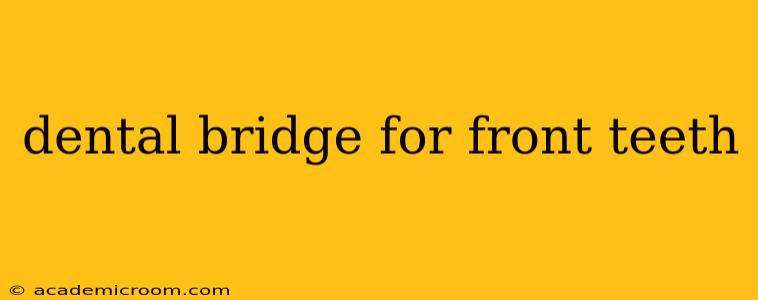A beautiful, healthy smile is a significant asset, and losing a front tooth can be devastating. Fortunately, dental bridges offer an excellent solution for restoring your smile's aesthetics and function. This comprehensive guide explores everything you need to know about dental bridges for front teeth, addressing common concerns and questions.
What is a Dental Bridge?
A dental bridge is a prosthetic device used to replace one or more missing teeth. It consists of artificial teeth (pontics) anchored to adjacent healthy teeth (abutments) using crowns. The crowns are cemented onto the abutment teeth, effectively "bridging" the gap created by the missing tooth or teeth. For front teeth, aesthetics are paramount, requiring precise fabrication and meticulous attention to detail.
Types of Dental Bridges for Front Teeth
Several types of dental bridges cater to different needs and situations. For front teeth, the focus is often on achieving a natural appearance:
- Traditional Bridges: These are the most common type, involving crowns on the abutment teeth supporting the pontic(s). They offer a strong and durable solution.
- Maryland Bonded Bridges: These use metal or porcelain frameworks bonded to the back of the abutment teeth. They are less invasive than traditional bridges, requiring less tooth reduction. However, they might not be as strong or durable, especially for replacing larger teeth or those under significant stress.
- Cantilever Bridges: Used when only one abutment tooth is available, this design anchors the pontic to a single crown. It's less common for front teeth due to the potential for increased stress on the abutment.
The dentist will determine the most suitable type of bridge based on your specific oral health, the number of missing teeth, and your aesthetic preferences.
How is a Dental Bridge for Front Teeth Placed?
The process typically involves several appointments:
- Consultation and Examination: The dentist assesses your oral health, examines the missing tooth/teeth, and discusses your treatment options.
- Preparation: The abutment teeth are prepared by gently removing a small layer of enamel to accommodate the crowns.
- Impressions: Impressions (molds) are taken of your teeth to create accurate models for the laboratory fabrication of the bridge.
- Temporary Bridge: A temporary bridge is placed to protect the prepared teeth and maintain your smile's appearance during the fabrication process.
- Bridge Placement: Once the permanent bridge is ready, the dentist will carefully cement it into place.
- Follow-up Appointments: Regular check-ups are crucial to monitor the bridge's condition and ensure proper oral hygiene.
How Long Do Dental Bridges Last?
With proper care and regular dental check-ups, a dental bridge can last for 10-15 years or even longer. However, factors like oral hygiene, diet, and bruxism (teeth grinding) can influence its longevity.
What are the Costs Involved?
The cost of a dental bridge for front teeth varies depending on the type of bridge, materials used, and the dentist's fees. It's advisable to consult with your dentist for a personalized cost estimate.
What are the Alternatives to Dental Bridges?
Alternatives to dental bridges for replacing missing front teeth include:
- Dental Implants: These are titanium screws surgically implanted into the jawbone, providing a strong and stable foundation for replacement teeth. They're considered the most permanent solution but are more invasive and expensive.
- Dentures (Partial or Full): These are removable prosthetic devices that replace missing teeth. They are less expensive than bridges or implants but may not be as aesthetically pleasing or comfortable for replacing front teeth.
How to Care for a Dental Bridge?
Proper oral hygiene is crucial for the longevity of your dental bridge. This includes:
- Brushing: Gently brush your teeth twice daily with a soft-bristled toothbrush and fluoride toothpaste. Pay special attention to the area around the bridge.
- Flossing: Floss daily to remove food particles and plaque from beneath the bridge and around the abutment teeth. Use floss threaders or interdental brushes if necessary.
- Regular Dental Check-ups: Visit your dentist for regular check-ups and professional cleanings to monitor the bridge's condition and maintain optimal oral health.
Are Dental Bridges Painful?
The procedure for placing a dental bridge generally involves minimal discomfort. Local anesthesia is used to numb the area, and any post-procedure pain is usually mild and manageable with over-the-counter pain relievers.
Can I Eat Normally with a Dental Bridge?
Yes, you can generally eat normally with a dental bridge after it’s fully settled. However, it's advisable to avoid excessively hard or sticky foods, especially in the initial weeks after placement, to prevent damage to the bridge or abutment teeth.
Remember, this information is for general knowledge and does not constitute medical advice. Always consult with a qualified dentist to determine the best treatment option for your individual needs and circumstances. A personalized consultation ensures you receive the most appropriate and effective care for your smile.
